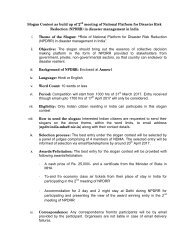National Disaster Management Guidelines School Safety Policy
School-Safety-Policy
School-Safety-Policy
You also want an ePaper? Increase the reach of your titles
YUMPU automatically turns print PDFs into web optimized ePapers that Google loves.
SCHOOL <strong>Safety</strong><br />
POLICY <strong>Guidelines</strong><br />
●<br />
Information related to hazards and<br />
risks posed by other facilities in<br />
the vicinity of the school e.g. any<br />
industrial establishments producing<br />
hazardous materials.<br />
3.2.2 Planning at the school level –<br />
inclusive and ongoing action<br />
Planning for emergencies at the school level cannot<br />
be done in isolation from the school community<br />
and the official structures responsible for schools.<br />
Therefore the planning exercise must be inclusive<br />
– involving wide range of representatives from<br />
the school and its neighbouring communities,<br />
including school administrators, school principals,<br />
school staff, students and key representatives<br />
from the community.<br />
It is equally important to recognize that planning<br />
for safety at the school level is not a one time or<br />
static process; it is an ‘on-going’ dynamic process<br />
involving identification of safety needs, developing<br />
prevention, response and preparedness protocols,<br />
evaluating physical facilities, and providing<br />
communication and training for staff members<br />
and students.<br />
The existing planning processes and protocols at<br />
the school level need to be adapted to adequately<br />
include safety concerns. For private and unaided<br />
schools, the <strong>National</strong> Accreditation Board for<br />
Education and Training needs to monitor safety<br />
aspects. In addition, as per the DM Act, DDMA<br />
needs to monitor all school buildings for their<br />
compliance with building codes.<br />
For schools under SSA, the current process<br />
of preparation of annual <strong>School</strong> Development<br />
Plans needs to reinforce focus on safety<br />
aspects. A comprehensive assessment of<br />
needs, conducted prior to the development of<br />
the <strong>School</strong> Development Plan (SDP) is essential<br />
for identifying the possible risks for children as<br />
well as their capabilities to respond and recover<br />
from critical incidents. The assessment should<br />
consider the history of natural disaster risk in<br />
the area and natural vulnerabilities, physical<br />
factors, such as the location of the school with<br />
regard to existing / emerging hazards, for<br />
example flooding due to proximity of a water<br />
body, building code requirements in relation<br />
to school structures as well as non-structural<br />
components that may threaten the well-being<br />
of children. It should also consider emergency<br />
uses of the school facility such as, school being<br />
designated as a relief shelter in the District<br />
<strong>Disaster</strong> <strong>Management</strong> Plans.<br />
The <strong>School</strong> <strong>Management</strong> Committee members,<br />
children and teachers being the primary users<br />
of the school are in the best position to identify<br />
and plan for addressing hazards and risks that<br />
may threaten their safety. Once the <strong>School</strong><br />
<strong>Management</strong> Committee has been formed and<br />
oriented to school safety issues, a dedicated group<br />
of individuals is available to lead the process of<br />
identifying risks and vulnerabilities.<br />
Any appropriate tool may be used to conduct the<br />
process of identifying needs in a participatory<br />
manner. For instance, ‘Hazard hunt’ exercise is a<br />
tested method to identify risks, both inside and<br />
outside the school precincts that may threaten<br />
the safety of the school community. It involves<br />
identifying all kinds of hazards including those that<br />
can cause physical harm such as deep potholes,<br />
lack of boundary walls; those that affect the<br />
health of children such as contaminated water<br />
sources, absence of toilets and hand washing<br />
facilities; as well those factors that are outside<br />
the school per se such as fast moving traffic on<br />
the road outside, ponds etc. (Refer Annexure 7)<br />
Based on the assessment of needs, the <strong>School</strong><br />
Development Plan needs to be prepared by the<br />
<strong>School</strong> <strong>Management</strong> Committee. NDMA through<br />
SDMA and DDMA will provide standard tool kits<br />
and render other inputs to facilitate the process.<br />
(Format of <strong>School</strong> DM Plan is available as<br />
Annexure 8)<br />
The plan would comprise measures to be taken<br />
both within school premises and in the immediate<br />
neighborhood including:<br />
1. Short term interventions : both nonstructural<br />
and structural activities<br />
2. Long- term interventions : both nonstructural<br />
and structural activities<br />
3. Training plan: For students and teachers<br />
4. Knowledge building plan including<br />
awareness creation, mass sensitization,<br />
mock-drills including follow up through<br />
regular school timetable. This would also<br />
include the use and regular maintenance<br />
of emergency equipments such as fire<br />
extinguishers.<br />
5. Review and Monitoring plan including<br />
safety audit, availability of emergency<br />
equipment and materials<br />
Section 3<br />
13



